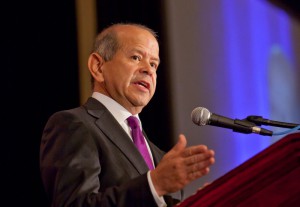
It’s a big change, and the industry is anxious to see what the future holds for drone integration under new leadership. As we witness the transfer, it seems appropriate to note the truly significant accomplishments that Michael Huerta achieved for the drone industry during his tenure.
I haven’t always been a Huerta fan. Three years ago, hearing Huerta speak at an AUVSI conference, I was quick to criticize the agonizing speed of regulations, the inefficient process of Section 333 Exemptions. Some people booed (quietly) when he took the stage. I joined colleagues in lackluster applause, blaming Michael Huerta for slowing down the growth of what was clearly an explosive business sector straining to take off. I wrote scathing articles outlining the many missed deadlines for drone regulations.
It was a rookie mistake. As time went on, and the complexities of drone regulation became clearer to me, I could see that railing against the speed of government was simply flailing at windmills. And Huerta was slowly and steadily working towards something big. He introduced collaboration into regulation.
While there were many practical reasons of manpower and resources to do this, Huerta wasn’t trying to just get some regulation – good, bad, or indifferent – done as fast as possible. He was trying to bring industry into the process, to figure it out fully. He was attempting not only to build bridges with the industry but also to eliminate bottlenecks – to lighten the load intelligently so that progress could be made more quickly.
It’s an approach that hasn’t always worked perfectly, and it has its drawbacks and naysayers. Companies included in the process get early information, and in some cases gain a competitive edge. Some opponents say that industry collaboration in regulation is the fox guarding the hen house – business can’t be expected to sacrifice its own interests in the good of the nation. Others claim that business people are simply not equipped to understand the complexities of the National Airspace.
All of that is probably true to some extent or another. But the fact remains that bringing representatives from all sides of an issue into a space to work together is still the fastest and most efficient way of exchanging critical viewpoints and information. And that has sped up the process of regulation.
It’s easy to list Huerta’s accomplishments by simply listing the regulations that passed under his watch – most notably, the Part 107 regulations that opened the skies to commercial drone businesses. But his lasting legacy may be more important: the idea that regulators and industry can actually – sometimes,at least – be on the same team.
When I heard Michael Huerta speak at last May’s AUVSI Xponential conference, his fourth, I joined the crowd in a genuinely enthusiastic welcome. He’d changed a bit over the years (the new goatee was quite dapper.) The tenor of his speeches had shifted too. “I am starting to feel a little bit like that uncle, the one who shows up every Thanksgiving, talks about some of the same things over and over, talks about some stuff that is new,” he said. He thanked the Drone Advisory Committee, and mentioned some of the new opportunities for collaboration with different industry sectors that had been put in place. “…There is no question in my mind that the significant milestones we have achieved so far are because stakeholders from across government and industry have come together,” he said.
Whether you love or loathe the FAA’s drone policies, Huerta did his best to give as many voices as possible a chance to speak. He moved things forward. He showed up to hear what the industry thought. And he showed genuine enthusiasm for the new technologies and capabilities that drones demonstrate.
Thank you, Michael Huerta.
Miriam McNabb is the Editor-in-Chief of DRONELIFE and CEO of JobForDrones, a professional drone services marketplace, and a fascinated observer of the emerging drone industry and the regulatory environment for drones. Miriam has penned over 3,000 articles focused on the commercial drone space and is an international speaker and recognized figure in the industry. Miriam has a degree from the University of Chicago and over 20 years of experience in high tech sales and marketing for new technologies.
For drone industry consulting or writing, Email Miriam.
TWITTER:@spaldingbarker
Subscribe to DroneLife here.